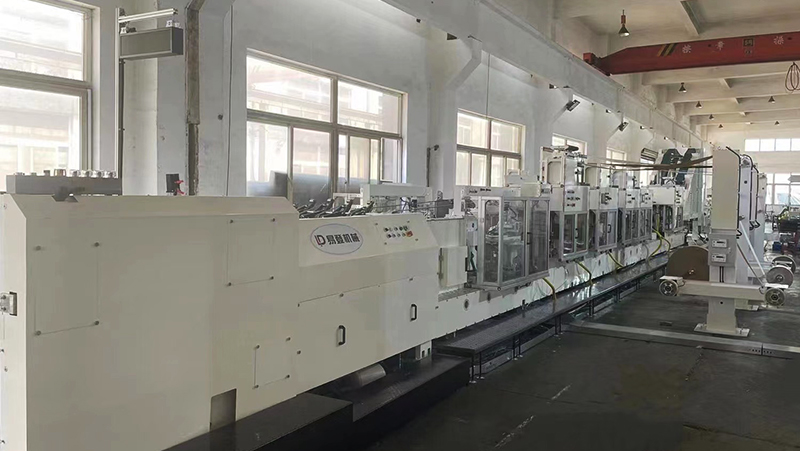Comprehensive Guide to Paper Bag Machine Specifications and Operational Considerations
Release time:2025-05-23 Classification:Knowledge
The production of paper bags relies heavily on specialized machinery designed to transform raw materials into functional, eco-friendly packaging solutions. Understanding the technical specifications of paper bag machines is critical for manufacturers aiming to optimize efficiency, ensure product consistency, and meet sustainability goals. This article provides an in-depth analysis of key machine specifications, operational requirements, and performance factors to guide decision-making in industrial settings.

1. Core Specifications of Paper Bag Machines
Modern paper bag machines are engineered with precision to handle diverse bag styles, including flat, satchel, twisted handle, and SOS (self-opening sack) designs. Below are essential specifications to evaluate:
Production Speed
- Measured in bags per minute (BPM), production speed defines output capacity. Standard machines operate between 30–200 BPM, depending on bag complexity.
- High-speed models integrate advanced servo systems for synchronized operations, minimizing downtime during size changes.
Material Compatibility
- Machines must accommodate varying paper grades (40–120 GSM) and adhesive types (water-based or hot melt).
- Adjustable tension controls ensure smooth handling of kraft, recycled, or laminated papers without tearing.
Bag Dimensions
- Adjustable tooling supports customizable lengths (150–600 mm), widths (80–400 mm), and handle lengths (200–800 mm).
- Precision cutting systems guarantee ±1 mm dimensional accuracy for uniform output.
Automation Features
- PLC (Programmable Logic Controller) systems enable preset configurations for rapid product switching.
- Sensors detect defects like misaligned handles or glue application errors, triggering automatic rejections.
2. Structural and Mechanical Components
A paper bag machine’s performance hinges on its mechanical design and component quality:
Feeding Unit
- Unwinders with automatic splicing ensure continuous paper roll feeding, critical for high-volume runs.
- Tension control mechanisms prevent wrinkles or slack during material transfer.
Printing Integration
- Optional flexographic printing units support up to 6 colors, with registration accuracy ≤0.1 mm.
- UV or water-based drying systems maintain print quality at high speeds.
Handle Attachment Systems
- For twisted-handle bags: Rotary twisters secure handles at 10–15 twists per minute.
- For flat handles: Adhesive application modules ensure bond strength ≥2 N/cm².
Bottom Sealing Mechanisms
- Heat-sealing units operate at 120–200°C, compatible with polyethylene-coated papers.
- Cold glue systems offer eco-friendly alternatives for uncoated materials.
3. Energy and Operational Efficiency
Sustainability and cost-effectiveness are prioritized in modern machine designs:
Power Consumption
- Standard machines require 15–30 kW, depending on automation levels.
- Energy recovery systems, such as regenerative braking in servo motors, reduce consumption by up to 20%.
Waste Reduction
- Scrap rates below 2% are achievable via precision cutting and real-time monitoring.
- Edge-trim recycling systems repurpose excess material into reusable pulp.
Noise Levels
- Sound-dampened enclosures maintain noise emissions below 75 dB, complying with workplace safety standards.
4. Maintenance and Safety Requirements
To ensure longevity and operator safety, consider these factors:
Lubrication Systems
- Centralized automatic lubrication reduces wear on chains, gears, and bearings.
- Maintenance intervals: 500–1,000 operational hours.
Safety Protocols
- Emergency stop buttons, light curtains, and interlock guards meet ISO 13849-1 safety standards.
- Dust extraction systems protect motors and electronics from paper particulate buildup.
Software Updates
- Remote diagnostics and firmware upgrades minimize downtime during troubleshooting.
5. Future-Proofing and Scalability
Investing in adaptable machinery prepares facilities for evolving market demands:
Modular Upgrades
- Add-ons like RFID tag embedding or QR code printing modules expand product capabilities.
- Compatibility with Industry 4.0 platforms enables data-driven production analytics.
Scalable Output
- Multi-line configurations allow parallel processing for large orders without compromising speed.
Selecting the right paper bag machine requires balancing technical specifications, operational costs, and sustainability objectives. By prioritizing precision engineering, automation, and energy efficiency, manufacturers can achieve high-quality output while reducing environmental impact. As consumer demand for eco-friendly packaging grows, advanced paper bag machines will remain indispensable tools in aligning production capabilities with global sustainability standards.
This guide outlines critical considerations without endorsing specific brands, ensuring an unbiased evaluation of paper bag machine capabilities. Always validate specifications through on-site testing to confirm compatibility with your production environment.






